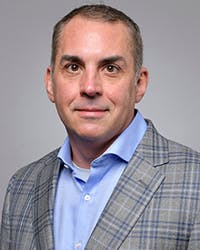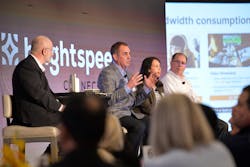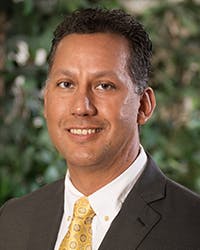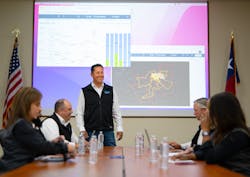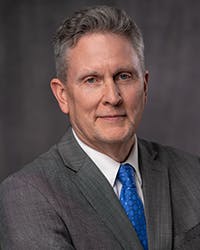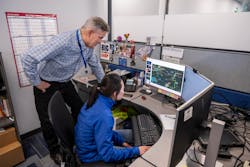Executive Insights with ISE EXPO’s Tech Talk Presenters
Their Perspectives Can Help Supercharge Your Career
These leaders walk in your shoes and have the scars to show it. From field fiber frenzies to trouble tickets that could have been prevented—they get you! These doers have distilled their years of experiences into network evolution wisdom that will help your team perform better and your reputation rise.
Topic: Your Tech Talk Topic and Title
ISE: Share the title of your Tech Talk and what attendees will learn to inspire network evolution greatness!
Bond: Brightspeed is transforming its network by upgrading its transport, metro, voice, access, and in-home network. Learn how our innovative approach could help your network efforts because it leverages a fully software-defined solution that includes digital twin capabilities and offers true real-time, end-to-end visibility across the entire network. The title of my Tech Talk presentation is “Network Evolution – Reaching Beyond Current Realities”.
Topic: Biggest Challenges
ISE: What are two big challenges you and your team face in terms of network evolution/transformation?
Bond: At Brightspeed, we are 100% cloud native. One of our first steps has been building the infrastructure that will host and manage our network evolution.
The team has been busy strategizing and architecting an end-to-end orchestration platform to enable management across the legacy and next-generation network elements. We will soon have full visibility and management capabilities across all network segments: transport, metro, and edge. This will allow us to better serve our customers and expand opportunities for customers who want to self-serve.
One of the biggest challenges has been managing customer demand with the current supply chain constraints. Many of our locations require transport augmentation for our new Consumer and Small Business Brightspeed Fiber and Fiber-to-the-Tower services. Several vendors are still experiencing extremely long lead times, preventing us from delivering services that our customers want. Some vendors have managed this better than others, but the legacy architecture does not allow us to mix and match network equipment, so a backlog with one vendor can impact our entire build.
Another challenge will be moving the legacy fiber inventory systems and customer records into our new systems stack. As part of the acquisition of incumbent local exchange carrier (ILEC) assets and associated operations across 20 states from Lumen Technologies (NYSE: LUMN) by Apollo-managed funds (NYSE: APO), we inherited multiple, outdated systems. To migrate the data, we have to extract it and load it to the new system. It will be a painstaking and time-consuming effort that demands flawless execution. Fortunately, our IT teams are the best in the industry and have the talent required to deliver this migration in record time while ensuring a seamless, unified customer experience.
“We are constantly looking for opportunities to reduce truck rolls, enable self-install, and create self-help capabilities.” —Brian Bond, Chief Operations Support & Innovation, Brightspeed
Topic: Worst of Two Evils
ISE: Which is more difficult to handle: supply chain challenges or workforce talent challenges? How should the industry address these challenges that have been a thorn in Broadband Service Providers’ sides for quite some time now?
Bond: Supply chain challenges are a larger issue for us because they are generally out of our control. With respect to workforce talent, we have been able to build and grow our teams with talent from across different industries. We have solid bench strength within each of our domains, so even where we need to hire and train new employees, we feel good about our ability to do so.
Topic: Operational Realities
ICT industry analysts and observers often focus on CAPEX budgets. But the reality is that OPEX can make or break the bottom line. The key to controlling OPEX is improving network life cycle management for complex fiber and legacy networks in a cost-efficient manner.
ISE: How is your company ensuring the networks it deploys are maintained in an operationally efficient manner?
Bond: At Brightspeed, we are being highly strategic in how we invest and innovate for the future. We are constantly looking for opportunities to reduce truck rolls, enable self-install, and create self-help capabilities. This starts with designing and creating a robust network that doesn’t require a lot of maintenance. Then we leverage digital and automated solutions for efficient order, activation, monitoring, and troubleshooting capabilities.
We are building our fiber network with new, innovative plug-and-play technologies that allow us to build to our customers and connect them faster than ever. When fiber repairs are needed, this technology enables us to fix it easily and efficiently, with minimal to no splicing required.
Topic: The Future
ISE: What emerging or disruptive broadband technology excites you the most? Why?
Bond: Three technologies excite me the most: cutting-edge pluggable upgrades to scale our optical network, development of an end-to-end orchestration platform, and a customer-friendly plan to evolve Wi-Fi standards from 6e to 7. These three components of our strategy will provide our customers with reliable, fast connections using the latest network and system technology.
First, we are focusing on upgrading our optical network to deliver greater spectrum efficiency and utilization. Newer pluggable technologies will give us the ability to scale beyond 1.2 TB in key strategic markets. Approximately 92% of our Enterprise customers consume services that ride our metro Ethernet network. Many of these customers have an immediate need for greater capacity to the edge. Therefore, in parallel with the optical enhancements, we are also upgrading our metro to a 100G core which will quickly position us to deliver 10G to the edge. In 2024, we will begin transitioning to a solution that will deliver a 400G Core allowing us to offer 100G Ethernet services.
Second, on top of our new robust network, Brightspeed is developing a platform that will allow us to provision and manage these devices and services end-to-end while creating visibility across our entire network. The new platform will allow us to retire legacy systems and will support both new and legacy equipment. In the Consumer and Small Business space, we are deploying XGS-PON and developing CPE that will enable us to deliver speeds up to 8G synchronously to the consumer. We recognize that most customers don’t have an immediate need for these services, but we are investing in the technology that offers even more reliability, capacity, and self-service mechanisms.
Finally, to round out the best customer experience, we are developing an in-home wireless solution that leverages Wi-Fi 6e. We will then transition to Wi-Fi 7 as the technology evolves. We don’t want our customers to have to think about using our service—our goal is to provide a superior customer experience that makes staying connected simple and easy.
Topic: Vendor Collaboration
ISE: What three things do you need from your vendor partners?
Bond: Product development from the customer’s point of view. Many vendors are still developing products that are designed for technicians to install and troubleshoot, which is extremely costly for service providers. We appreciate vendors with people who are more customer- and operations-focused to assist with developing solutions that help reduce OPEX.
API-first mentality—Brightspeed is building our own cloud-native BSS/OSS stack. We don’t necessarily have a need for vendors to bring us flashy user interfaces—we prefer to integrate with them directly via APIs so that we can create a single pane of glass for our agents and technicians, then leverage those same APIs for customer-facing apps.
We need our vendors to solve their supply chain challenges. The vendors that do this will be the ones who win our long-term strategic partnership.
Topic: Drive
ISE: What ONE thing motivates you to do what you do each morning? Relationships, money, success, or something else?
Bond: I was born and raised in rural America, and bandwidth has always been an issue for folks in my state. Working for Brightspeed is exciting and motivating for me because I know we’re making a difference for communities like mine. Every day is an opportunity to close the gap for underserved markets, with access to improved distance learning, remote work, telemedicine, and all the things that people in other areas take for granted. Each day is a chance to improve the quality of life for our customers and communities.
Topic: Your Tech Talk Topic and Title
ISE: Share the title of your Tech Talk and what attendees will learn to inspire network evolution greatness!
Cano: When I look at the state and federal maps, they look nothing like the reality from a boots-on-the-ground perspective. The current maps paint a foggy view of what currently exists in terms of broadband services. Even worse, the maps don’t show what customers are experiencing.
Undoubtedly, the maps will evoke a bit due to the challenge period and public feedback. But the lack of detail is disturbing. The problem is being painted in two dimensions: Is that a broadband serviceable location and what is the technology potential? The real problem is multidimensional. Decision makers need to consider what the uptime and dependability of the current network is, will it scale and grow with the usage trends, and what is the trouble response reliability of the provider? Some customers are waiting days and weeks for technicians to resolve their issues. That’s frustrating to know that funding decisions will be made with incomplete knowledge and understanding of the networks.
The potential of fiber is life-changing to our customers—those who are trying to better themselves and their families. Alternative solutions don’t provide the future-proof symmetrical speeds and network reliability people in rural communities deserve.
My childhood years of farming and ranching gave me a great appreciation for the hard work it takes to survive in ranching and farming. This hard work life is passed down through generations. These hard-working families deserve more than an alternative technology. They deserve the BEST technology.
The title of my Tech Talk presentation is “Multidimensional Challenges of Mapping – Reading Between the Lines to Create a True Broadband Roadmap for the Underserved”. You should attend this talk because you will hear the technical truths around this politicized issue.
Topic: Biggest Challenges
ISE: What are two big challenges you and your team face in terms of network evolution/transformation?
Cano: Talent development is critical. Etex now performs all OSP engineering, permit acquisition, splicing, equipment installation and turn up with internal teams. These teams are involved in the vision and planning from the beginning. Of course, our long-lasting supplier and contractor partnerships are an integral part of our plan. However, the main ingredient that makes this successful is our employees. Having staff who live in the communities we serve establishes the accountability and intimate knowledge of our territory and customers. Our employees take great pride in serving our friends and neighbors.
Network security must be an industry priority. Cyberthreats and ransomware continue to increase. Every new connection is a new potential victim to this crime wave. Providers must continue to keep up with software upgrades and added appliances to deploy a trusted network. Additionally, we must work with our communities to provide continued education and support on cybersecurity as part of our digital literacy efforts.
Topic: Operational Realities
ICT industry analysts and observers often focus on CAPEX budgets. But the reality is that OPEX can make or break the bottom line. The key to controlling OPEX is improving network life cycle management for complex fiber and legacy networks in a cost-efficient manner.
ISE: How is your company ensuring the networks it deploys are maintained in an operationally efficient manner?
Cano: Etex is in the process of adding new 400GB fiber rings to increase capacity and keep pace with customer growing demands. This will reduce network vulnerabilities and increase reliability by segregating network elements. We are also adding a new upstream Internet link to existing dual connections. This will increase stability and enable new peering service offerings.
Topic: Vendor Collaboration
ISE: What three things do you need from your vendor partners?
Cano: I’d boil it down to ONE thing—vendors. They must be sincere about working within your budget. Etex had to find the next-generation fiber and routing solution to address our massive growth. That’s easy if you're flush with cash. The trick is finding a solution that has to fit within a flat budget.
“When I look at the state and federal broadband maps, they look nothing like the reality from a boots-on-the-ground perspective." —Charlie Cano, CEO/General Manager, Etex Telephone Cooperative
Topic: The Elephant in the Room
ISE: What is the industry NOT addressing that it should related to network evolution and broadband for all?
Cano: Rural providers are deeply invested to close the digital divide in their markets. While politicians are now focused on unserved or underserved areas, the small providers have always focused on their rural customers and have delivered better broadband speeds compared to similar areas with low density customer counts.
The second important issue we must double down on is engineering best practices—because in broadband engineering, there’s no such thing as being technology neutral. Think about it in terms of best practices for building highways and structures. There is no such thing as being material neutral when building them to last. So, while there is a niche for fixed wireless or satellite solutions for some extremely rural areas, fiber optic facilities must be the priority to build a resilient network for the long-haul.
Topic: Advice
ISE: What would you tell emerging leaders as they try to make a difference in the industry AND propel their careers to the next level?
Cano: Well, being the engineering and math nerd that I am, I actually developed and solved the formula for leadership success.
Leadership Success (LS) comes from realizing that the professional focus should be constant from beginning to end—from the day you are hired through retirement. Once hired, three things develop your success.
First, we all graduate with a skill that translates to our work performance. It is what you bring to the table.
Add to that a double dose of grit, which is the fire (your background, challenges, motivators) that inspires you to educate yourself and evolve. Everyone has a story, something that pushes you to overcome obstacles. Grit also represents your potential to grow. We are never done learning.
A significant companion to grit is the golden rule: treating your team members with respect, honor, and integrity. That goes a long way, both at the beginning and end of a career.
Finally, understand that the professional individual you are today will not be the same in the future, and you don’t want to be. Do not resist change, for it will decrease your potential for continued success.
Topic: Your Tech Talk Topic and Title
ISE: Share the title of your Tech Talk and what attendees will learn to inspire network evolution greatness!
Amundson: The title of my Tech Talk presentation is “Creating an Equilibrium Between Speed/Labor/Technology & Cost/Revenue/Profit”. This Tech Talk focuses on how to plan realistically and build lean—don’t make things more complicated than they need to be to reach your goals.
Topic: Worst of Two Evils
ISE: Which is more difficult to handle: supply chain challenges or workforce talent challenges? How should the industry address these challenges that have been a thorn in Broadband Service Providers’ sides for quite some time now?
Amundson: Workforce is the tougher challenge. Supply chain issues are being solved by the force of the free market and the prevailing tension provided by profit motive. We are turning the corner on supply chain concerns.
Workforce, however, is another issue all together in terms of recruitment and retention. To build a robust internal workforce, an organization needs a combination of communicated and clear career path options involving training and skills development, coupled with advantageously leveraging workforce diversity. In terms of recruitment, an organization can be limited in terms of salary and benefits to entice new hires. On the positive side, with the new remote work environment, we now have a larger and more diverse applicant pool and talent who wouldn’t have considered working for us in the past.
Topic: Vendor Collaboration
ISE: What three things do you need from your vendor partners?
Amundson: Understanding our business model. The most important thing I need from my vendor partners is innovation that is on pace or ahead of our needs. Our vendor partners should understand what we are building, and that as we change our designs, change with us. We are making those adjustments in real time to improve our cost models by lower material costs and more importantly, lower labor costs.
Understand size does matter. Terminals are a great example, but it starts with the cable. If I use a fixed size of cable for most of my build, then I need one type of terminal for most of my build as well. We don’t need one terminal that handles 20 different scenarios—I need a terminal that handles two. These choices have an impact on the cost of materials and ultimately labor costs.
If there’s a better way to do something—tell us. We need to spend more time with our vendors simplifying what we are doing. A great example is the bidding process. There may be a discrepancy between what’s on our list and what the contractor thinks we should have on it. Having a better understanding of each other’s wants and needs will go a long way toward getting the desired result.
Topic: Network Automation
ISE: Share how your company is approaching network automation.
Amundson: TDS, like many others in the space, must deal with older SMNP-based equipment. We have automated everything possible, but that model only goes so far. We are moving to systems based on NETCONF/YANG but that has issues as well, chiefly disparate management systems. Conversion and integration across vendor platforms aren’t small issues. Our goal is to unify our access network under a common control plane—the path to the goal has been hard to follow but one which we are continuing to evaluate.
Topic: The Elephant in the Room
ISE: What is the industry NOT addressing that it should related to network evolution and broadband for all?
Amundson: We spend a lot of time creating for perfection when perfection isn’t needed. We also spend time and money building networks for the “what ifs” of the future. In my experience, both lead to excess cost and stranded assets. I don’t mean we should throw rationality out the window, but we should understand the actual requirements of the plan and build to those requirements. The future is never certain, and neither is technology (reference NGPON2). Plan realistically, build lean.
“Our vendor partners should understand what we are building, and that as we change our designs, change with us.” —John Amundson, Director of Planning & Implementation, TDS Telecom
Topic: Your Passion
ISE: Share one problem/challenge you are passionate about solving for the ICT Industry.
Amundson: With $42.45 billion dollars that will soon be allocated to states for broadband deployment, I am passionate about finding efficiencies in network design and deployment that can meet the aggressive timelines and expectations. We need to find economical solutions to bring broadband to unserved and underserved areas that don’t break the bank and allow us to reach the maximum number of service addresses.
Topic: Advice
ISE: What would you tell emerging leaders as they try to make a difference in the industry AND propel their careers to the next level?
Amundson: Think. Seems simple but it is one of the most critical attributes to job performance. We often spend time doing things according to established processes under the guise of this is how we do it and never ask why. I am referring specifically to the process details that are buried down in the minutiae of the organization. Bottom-up improvements are often the gold we dig for, but unless we get deep enough into the dirt, we won’t find it.
Be humble and stay humble. Remember, people don’t work for you—they work for a paycheck or personal satisfaction, or some other driver that is not you personally. The former might be true in some cases but those are rare and fleeting. Sometimes the hardest thing for leaders to do is deflate your ego, sit on your hands, and shut up. Listening and leading go hand-in-hand.
Topic: Biggest Challenges
ISE: What are two big challenges you and your team face in terms of network evolution/transformation?
Travers: COVID-19 and the subsequent supply chain disruption drastically shifted how we approached our network deployment. The pandemic occurred right as we were in the midst of our 5G network build-out. Our top priority was to keep our employees safe while keeping our customers connected when it mattered most. To that, we saw the challenge as an opportunity to double down on our 5G network and raised our CAPEX guidance soon after the pandemic began to actually invest more than we had originally planned.
Topic: Worst of Two Evils
ISE: Which is more difficult to handle: supply chain challenges or workforce talent challenges? How should the industry address these challenges that have been a thorn in Broadband Service Providers’ sides for quite some time now?
Travers: Both are difficult but in different ways. We have trusted relationships with our suppliers, however we were also susceptible to global supply chain challenges. We worked through these challenges with a combination of smart forward planning and flexibility. It wasn’t uncommon for us to work around delays and/or find alternatives to ensure a project was completed.
We’ve approached workforce challenges from a different perspective. We’ve been fortunate to have relatively low turnover, however we’re always looking at how to attract and recruit talent to our network teams. We’ve approached this by reevaluating the requirements of our job postings to better emphasize the precise skills we are looking for.
We also are big believers in the talents and abilities of our country’s veterans. Many of whom already possess the skills and background to succeed in the industry. Verizon has ranked as a Top Military Friendly® Company for the fifth consecutive year and the company employs over 8,000 military veterans.
"Innovation is what drives our industry but often the price of innovation is failure. You can’t be afraid of failure provided you use it as a learning tool."—Ashley Travers, Director of Network Engineering, Verizon
Topic: Operational Realities
ICT industry analysts and observers often focus on CAPEX budgets. But the reality is that OPEX can make or break the bottom line. The key to controlling OPEX is improving network life cycle management for complex fiber and legacy networks in a cost-efficient manner.
ISE: How is your company ensuring the networks it deploys are maintained in an operationally efficient manner?
Travers: We are building our next generation 5G network and we are decommissioning legacy assets. Decommissioning these assets is improving operational costs, driving energy efficiency, and delivering the best experience possible for our customers.
Topic: The Future
ISE: What emerging or disruptive broadband technology excites you the most? Why?
Travers: Fixed wireless access is one of the most disruptive technologies, both for consumers and businesses. For consumers, it’s leveraging our 5G network to deliver more Internet choice in many parts of the country.
For businesses, it's ideal for use cases like small offices, mobile retail, kiosks, and temporary business locations. What’s important for businesses is you get the security of Verizon’s network along with scalability.
Topic: Vendor Collaboration
ISE: What three things do you need from your vendor partners?
Travers: Trust, transparency, and shared objectives. All of our approved vendors must adhere to strict guidelines regarding sourcing and ethics.
Topic: Failure
ISE: Talk about it.
Travers: I believe in the adage of “fail fast” and move on. Failure often means you tried something new. However, the most important thing about failure is to learn from it and not make the same mistakes twice. Innovation is what drives our industry but often the price of innovation is failure. You can’t be afraid of failure provided you use it as a learning tool.
“Fixed wireless access is one of the most disruptive technologies, both for consumers and businesses.” —Ashley Travers, Director of Network Engineering, VerizonTopic: Retaining and Retraining Top Talent
The great resignation is not ending. How does your team hold onto professionals with the most talent and the greatest work ethic when they must upskill to remain relevant? (Oftentimes, “upskilling” translates into working their day job and at the same time learning new skills for the future.)
ISE: Share your thoughts about the “rub” of this reality to employers AND employees.
Travers: We are fortunate to have a team that has been with us for a long time. However, one element I am passionate about is getting women comfortable in engineering and technology. There’s a perception that you “need to be an engineer” or need to be directly involved in technology to work in the industry, and that is not true. Especially now, where technology is a part of everything—the ability to broadly understand how technology works and how it interacts with the business is vital. My background isn’t engineering but my career has been spent working in network technology and it’s been incredibly enlightening and rewarding because I allowed myself to not get intimidated by it, but rather open to learning it.
Topic: Emotional Intelligence
ISE: As you work through network obstacles, what have you learned about yourself and others that surprised you?
Bond: Over the course of my career, one thing has been consistent. How you treat people and the culture you create will determine your success. I have been fortunate to work with some of the most talented and amazing people over the past 20+ years. I have learned to treat people well, remain humble, trust my teams, and empower them to make decisions.
Topic: Emotional Intelligence
ISE: As you work through network obstacles, what have you learned about yourself and others that surprised you?
Cano: I believe in the statement “luck favors hard work”. Grit and perseverance are shared traits with all successful leaders. I feel blessed to be in a leadership role. I work hard to demonstrate to my company and peers that I do not take it for granted. My work ethic is a product of lessons learned in life with positive mentors and also negative individuals who attempted to hinder my growth. I appreciate those lessons and apply the golden rule to “treat others as you want to be treated”. I feel these principles have put me in position for some luck along the way.
Topic: Retaining and Retraining Top Talent
The great resignation is not ending. How does your team hold onto professionals with the most talent and the greatest work ethic when they must upskill to remain relevant? (Oftentimes, “upskilling” translates into working their day job and at the same time learning new skills for the future.)
ISE: Share your thoughts about the “rub” of this reality to employers AND employees.
Amundson: Clear and open communication along with a feeling of belonging are parts of talent retention but that must be bolstered by skills development and career path transparency. Skills development must include both technical training and leadership training. To be clear, every associate hired may not want to progress into leadership positions, and that is fine. But for those who do, we need to make it very clear what it takes and provide skills training and opportunities to prepare them for the future. For those interested in technical skills, we must ensure we grow those associates and provide meaningful career paths for them as well.
There is no perfect model for retention, no secret sauce, and if there was, it would change with every new addition to a team. We are all humans with different expectations of how we want to be treated. Organizations can’t solve for all of them, but we can be open and honest about who we are and what we stand for. When we find good people, we must make sure they are understood, recognized, and valued.
Topic: Drive
ISE: What ONE thing motivates you to do what you do each morning? Relationships, money, success, or something else?
Travers: I’m motivated by the opportunity to do something different each day. I’ve been fortunate to have many network roles at Verizon and I’ve had the opportunity to learn from many different people and undertake new challenges. No day is ever the same which is probably why I’ve been here as long as I have.
Check out everything ISE EXPO 2023 has to offer and register today!
About the Author
Sharon Vollman
Content Ambassador for ISE EXPO
Sharon Vollman is the Content Ambassador for ISE EXPO. She is passionate about collaborating with thought leaders, SMEs and hard-working doers who design, plan and deploy ultra-reliable broadband networks. Vollman is committed to creating a variety of educational offerings for ISE EXPO attendees that inspire them to connect every U.S. citizen with the broadband networks we all want for our children and grandchildren.
Vollman has created educational partnerships with Broadband Service Providers including AT&T, Verizon, Lumen, Frontier Communications and others. She has covered the telecom industry since 1996.

